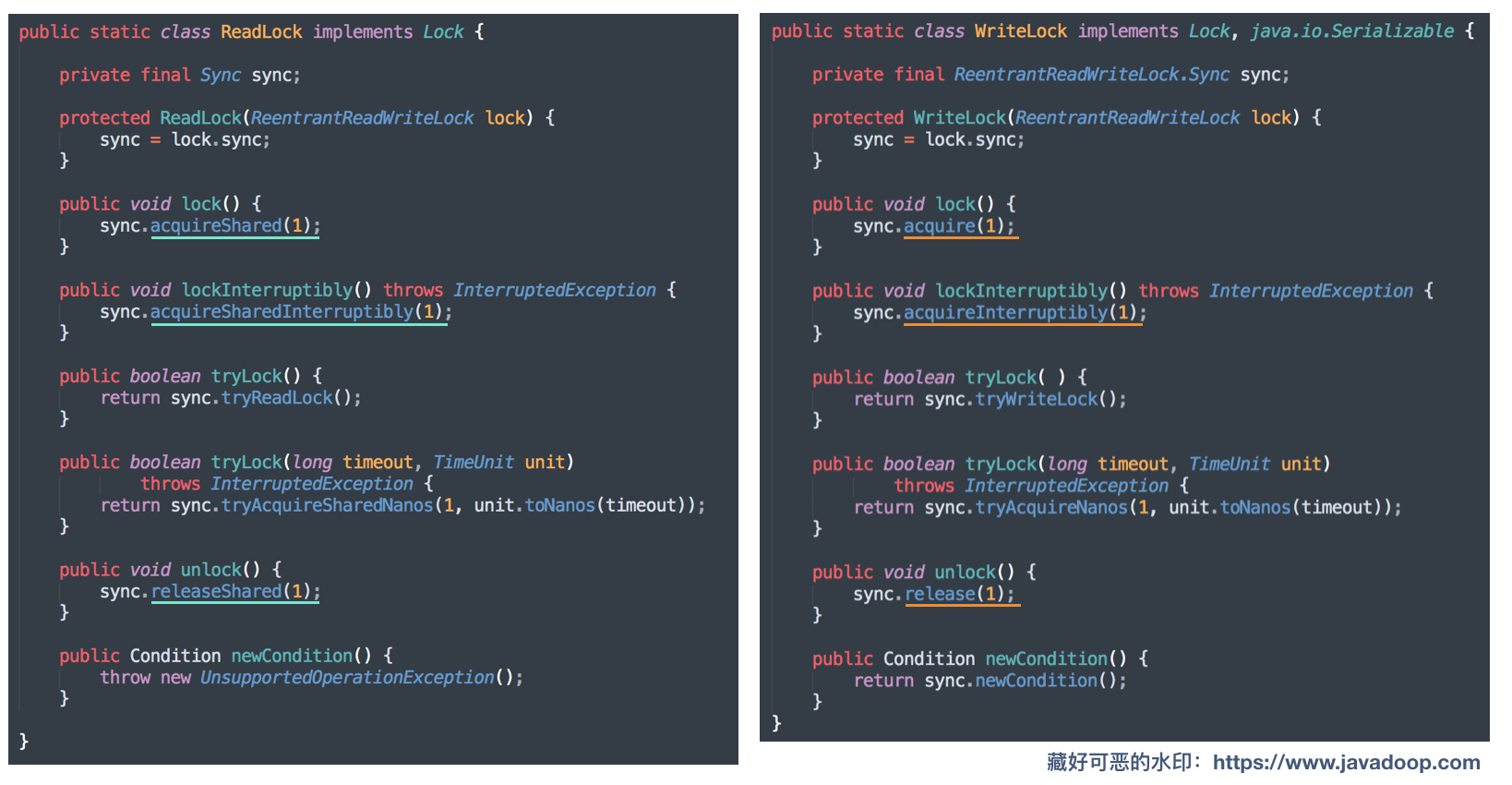先做总结:
1、为什么用读写锁 ReentrantReadWriteLock?
重入锁ReentrantLock是排他锁,在同一时刻仅有一个线程可以进行访问,但是在大多数场景下,大部分时间都是提供读服务,而写服务占有的时间较少。然而读服务不存在数据竞争问题,如果一个线程在读时禁止其他线程读势必会导致性能降低。所以就提供了读写锁。
读写锁维护着一对锁,一个读锁和一个写锁。通过分离读锁和写锁,使得并发性比一般的排他锁有了较大的提升:在同一时间可以允许多个读线程同时访问,但是在写线程访问时,所有读线程和写线程都会被阻塞。
2、读写锁实现原理:
(1)每个ReentrantReadWriteLock对象都对应着读锁和写锁两个锁。
(2)ReentrantReadWriteLock通过其属性sync(继承了AQS),一个对象实现了读写两个锁。
(3)sync.state(int)分为高 16 位和低16位,高16位用于共享模式ReadLock,低16位用于独占模式WriteLock
(4)获取写锁标志:
1.sync.state的低16位(0代表没有被占用,大于0代表有线程持有当前锁(锁可以重入,每次重入都+1) 最多2^16-1次重入
2.sync.exclusiveOwnerThread == Thread.currentThread()
(5)获取读锁标志:
1.state的高16位(0代表没有被占用,大于0代表有线程持有当前锁(锁可以重入,每次重入都+1) 最多2^16-1次重入
2.ThreadLocalHoldCounter readHolds; // 记录线程持有的读锁数量(ThreadLocalHoldCounter extends ThreadLocal)
readHolds.threadLocals - Map<ThreadLocal, HoldCounter>
HoldCounter - count tid
(关于ThreadLocal:Java并发(二十):线程本地变量ThreadLocal)
3.sync.cachedHoldCounter 记录最后一个获取读锁的线程的读锁重入次数,用于缓存提高性能
4.sync.firstReader 第一个获取读锁的线程(并且其未释放读锁),以及它持有的读锁数量 提高性能
(6)ReentrantReadWriteLock的内部类WriteLock/ReadLock通过操作sync的属性实现的锁的操作。
一、类结构
public class ReentrantReadWriteLock implements ReadWriteLock, java.io.Serializable { // 属性 private final ReentrantReadWriteLock.ReadLock readerLock; private final ReentrantReadWriteLock.WriteLock writerLock; final Sync sync; // 锁 // 内部类 abstract static class Sync extends AbstractQueuedSynchronizer {} static final class FairSync extends Sync {} static final class NonfairSync extends Sync {} public static class ReadLock implements Lock, java.io.Serializable {} public static class WriteLock implements Lock, java.io.Serializable {} }
二、读写锁实现

ReadLock 使用了共享模式,WriteLock 使用了独占模式。
ReadLock 和 WriteLock都是通过同一个Sync实例实现的。
AQS 将 state(int)分为高 16 位和低16位,高16位用于共享模式ReadLock,低16位用于独占模式WriteLock 。
static final int SHARED_SHIFT = 16; static final int SHARED_UNIT = (1 << SHARED_SHIFT); static final int MAX_COUNT = (1 << SHARED_SHIFT) - 1; static final int EXCLUSIVE_MASK = (1 << SHARED_SHIFT) - 1; static int sharedCount(int c) { return c >>> SHARED_SHIFT; } // 无符号补0右移16位 - 读锁 static int exclusiveCount(int c) { return c & EXCLUSIVE_MASK; } // 抹掉高16位 - 写锁
WriteLock:
1.state的低16位(0代表没有被占用,大于0代表有线程持有当前锁(锁可以重入,每次重入都+1) 最多2^16-1次重入
2.exclusiveOwnerThread == Thread.currentThread()
ReadLock:
1.state的高16位(0代表没有被占用,大于0代表有线程持有当前锁(锁可以重入,每次重入都+1) 最多2^16-1次重入
2.ThreadLocalHoldCounter readHolds; // 记录线程持有的读锁数量
readHolds.threadLocals - Map<Thread, HoldCounter>
HoldCounter - count tid
三、源码分析
写锁获取:
// ReentrantReadWriteLock.WriteLock.lock() public void lock() { sync.acquire(1); } // AbstractQueuedSynchronizer.acquire(int) public final void acquire(int arg) { if (!tryAcquire(arg) && acquireQueued(addWaiter(Node.EXCLUSIVE), arg)) selfInterrupt(); } /** * ReentrantReadWriteLock.Sync.tryAcquire(int) * 可以获取写锁的两种情况: * 1.没有线程占用该锁(读锁和写锁都没有被占用) * 2.当前线程已经拿到过该写锁,重入 */ protected final boolean tryAcquire(int acquires) { Thread current = Thread.currentThread(); int c = getState(); int w = exclusiveCount(c); // 写锁 if (c != 0) { // 有锁 if (w == 0 || current != getExclusiveOwnerThread()) // 有锁且没有写锁(即有读锁) || 其他线程占用了写锁 return false; if (w + exclusiveCount(acquires) > MAX_COUNT) // 重入锁上限 2^16-1 throw new Error("Maximum lock count exceeded"); setState(c + acquires); return true; } // 没有线程占用该锁,直接获取锁 if (writerShouldBlock() || // 如果是公平锁需要排队 !compareAndSetState(c, c + acquires)) return false; setExclusiveOwnerThread(current); return true; }
写锁释放:
// ReentrantReadWriteLock.WriteLock.unlock() public void unlock() { sync.release(1); } // AbstractQueuedSynchronizer.release(int) public final boolean release(int arg) { if (tryRelease(arg)) { Node h = head; if (h != null && h.waitStatus != 0) unparkSuccessor(h); return true; } return false; } /** * ReentrantReadWriteLock.Sync.tryRelease(int) * 释放写锁:维护state和exclusiveOwnerThread * */ protected final boolean tryRelease(int releases) { if (!isHeldExclusively()) throw new IllegalMonitorStateException(); int nextc = getState() - releases; boolean free = exclusiveCount(nextc) == 0; if (free) setExclusiveOwnerThread(null); setState(nextc); return free; }
读锁
abstract static class Sync extends AbstractQueuedSynchronizer { // 这个嵌套类的实例用来记录每个线程持有的读锁数量(读锁重入) static final class HoldCounter { int count = 0; // 持有的读锁数 final long tid = getThreadId(Thread.currentThread()); // 线程 id } static final class ThreadLocalHoldCounter extends ThreadLocal<HoldCounter> { public HoldCounter initialValue() { return new HoldCounter(); } } /** * 组合使用上面两个类,用一个 ThreadLocal 来记录线程持有的读锁数量 */ private transient ThreadLocalHoldCounter readHolds; /** * 用于缓存,记录最后一个获取读锁的线程的读锁重入次数 * 不管哪个线程获取到读锁后,就把这个值占为已用,这样就不用到 ThreadLocal 中查询 map 了 * 通常读锁的获取很快就会伴随着释放,在 获取->释放 读锁这段时间,如果没有其他线程获取读锁的话,此缓存就能帮助提高性能 */ private transient HoldCounter cachedHoldCounter; /** * 第一个获取读锁的线程(并且其未释放读锁),以及它持有的读锁数量 * 提高性能用 */ private transient Thread firstReader = null; private transient int firstReaderHoldCount; }
读锁获取:
// ReentrantReadWriteLock.ReadLock.lock() public void lock() { sync.acquireShared(1); } // AbstractQueuedSynchronizer.acquireShared(int) public final void acquireShared(int arg) { if (tryAcquireShared(arg) < 0) doAcquireShared(arg); } /** * ReentrantReadWriteLock.Sync.tryAcquireShared(int) * 可以获取读锁情况: * 1.没有线程占用该锁 * 2.只有读锁 * 3.有写锁,写锁被当前线程占用,锁降级 * 三种情况 - 只要没有其他线程占用写锁就可以获取读锁 */ protected final int tryAcquireShared(int unused) { Thread current = Thread.currentThread(); int c = getState(); if (exclusiveCount(c) != 0 && getExclusiveOwnerThread() != current) // 其他线程占用写锁 return -1; int r = sharedCount(c); // 读锁 if (!readerShouldBlock() && r < MAX_COUNT && compareAndSetState(c, c + SHARED_UNIT)) { // 进入此if,表示可以拿到读锁了 if (r == 0) { // 将"第一个"获取读锁的线程记录在firstReader属性中 firstReader = current; firstReaderHoldCount = 1; } else if (firstReader == current) { firstReaderHoldCount++; } else { // 1.当前线程及对应读锁次数存入cachedHoldCounter 2.当前线程及对应读锁次数存入readHolds HoldCounter rh = cachedHoldCounter; if (rh == null || rh.tid != getThreadId(current)) cachedHoldCounter = rh = readHolds.get();// readHolds中取当先线程的ThreadLocal(没有就创建一个) else if (rh.count == 0) readHolds.set(rh); rh.count++; } return 1; } return fullTryAcquireShared(current);// 公平锁排队非公平锁下一个是写锁/读锁重入次数上限/CAS失败 重新拿读锁 } /** * ReentrantReadWriteLock.Sync.fullTryAcquireShared(Thread) */ final int fullTryAcquireShared(Thread current) { HoldCounter rh = null; for (;;) { // 循环CAS拿锁 int c = getState(); if (exclusiveCount(c) != 0) { if (getExclusiveOwnerThread() != current) // 其他线程占用写锁 return -1; } else if (readerShouldBlock()) { // 处理读锁重入,将cachedHoldCounter设置为当前线程 if (firstReader == current) { // assert firstReaderHoldCount > 0; } else { if (rh == null) { rh = cachedHoldCounter; if (rh == null || rh.tid != getThreadId(current)) { rh = readHolds.get(); if (rh.count == 0) readHolds.remove(); } } if (rh.count == 0) // 不是重入,返回-1 return -1; } } if (sharedCount(c) == MAX_COUNT) throw new Error("Maximum lock count exceeded"); if (compareAndSetState(c, c + SHARED_UNIT)) { // 正常拿读锁 if (sharedCount(c) == 0) { firstReader = current; firstReaderHoldCount = 1; } else if (firstReader == current) { firstReaderHoldCount++; } else { if (rh == null) rh = cachedHoldCounter; if (rh == null || rh.tid != getThreadId(current)) rh = readHolds.get(); else if (rh.count == 0) readHolds.set(rh); rh.count++; cachedHoldCounter = rh; // cache for release } return 1; } } }
锁降级:
持有写锁的线程,去获取读锁的过程称为锁降级
读锁释放:
// ReentrantReadWriteLock.ReadLock.unlock() public void unlock() { sync.releaseShared(1); } // AbstractQueuedSynchronizer.releaseShared(int) public final boolean releaseShared(int arg) { if (tryReleaseShared(arg)) { doReleaseShared(); return true; } return false; } /** * ReentrantReadWriteLock.Sync.tryReleaseShared(int) * 维护readHolds state */ protected final boolean tryReleaseShared(int unused) { Thread current = Thread.currentThread(); if (firstReader == current) { // 第一个获取读锁的线程 if (firstReaderHoldCount == 1) firstReader = null; else firstReaderHoldCount--; } else { // readHolds中次数-1 HoldCounter rh = cachedHoldCounter; if (rh == null || rh.tid != getThreadId(current)) rh = readHolds.get(); int count = rh.count; if (count <= 1) { readHolds.remove(); if (count <= 0) throw unmatchedUnlockException(); } --rh.count; } for (;;) { // state int c = getState(); int nextc = c - SHARED_UNIT; if (compareAndSetState(c, nextc)) // Releasing the read lock has no effect on readers, // but it may allow waiting writers to proceed if // both read and write locks are now free. return nextc == 0; } }